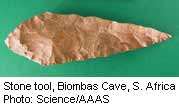
THURSDAY, Oct. 28 (HealthDay News) Early humans were using a highly skilled stone tool sharpening method 75,000 years ago in Africa, more than 50,000 years earlier than previously believed, a new study indicates.
This adds more evidence that modern behavior developed over time during the Middle Stone Age rather than after our ancestors migrated from Africa to Europe, as some scientists have thought.
Researchers from the University of Colorado at Boulder discovered that the delicate technique — called “pressure flaking” — was used by anatomically modern humans at Blombos Cave in South Africa during the Middle Stone Age. Previously, the earliest evidence of pressure flaking was from 20,000 years ago in France and Spain.
“This finding is important because it shows that modern humans in South Africa had a sophisticated repertoire of tool-making techniques at a very early time,” study co-author Paola Villa, a curator at the University of Colorado Museum of Natural History, said in a university news release.
“This innovation is a clear example of a tendency to develop new functional ideas and techniques widely viewed as symptomatic of advanced, or modern behavior,” she added.
Pressure flaking “takes place when implements previously shaped by hard stone hammer strokes followed by softer strikes with wood or bone hammers are carefully trimmed on edges by directly pressing the point of a tool made of bone on the stone artifact,” according to background material in the study. Many stones — with the exception of jasper, obsidian and high-quality flint — also had to be heated before pressure flaking, researchers noted.
This technique enables better control of the sharpness, thickness and overall shape of two-sided items such as spearheads and stone knives, Villa explained.
The study appears in the Oct. 29 issue of Science.
More information
The Australian Museum has more about tools and human evolution.

